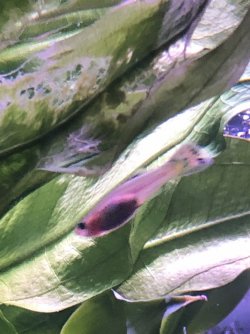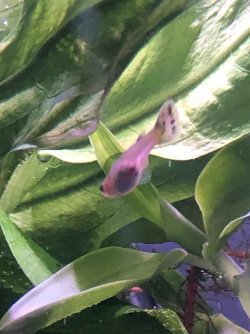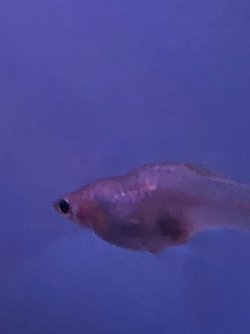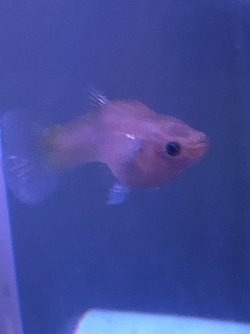The pH shows the highest colour for that tester. it could be 7.6 or higher than 7.6. Have you tested with the high range pH tester to make sure it's not higher than 7.6? The amount of free ammonia increases as the pH gets higher.
You are using an out of date browser. It may not display this or other websites correctly.
You should upgrade or use an alternative browser.
You should upgrade or use an alternative browser.
Potential emergency? Freshwater tank with high Ammonia
- Thread starter GrayTeall
- Start date
The April FOTM Contest Poll is open!

🏆 Click to vote! 🏆
Oblio
Fish Herder
The pH shows the highest colour for that tester. it could be 7.6 or higher than 7.6. Have you tested with the high range pH tester to make sure it's not higher than 7.6? The amount of free ammonia increases as the pH gets higher.
Nitrite and nitrate levels are still 0 and my pH is at 7.6, which is the test's maximum, but yesterday I used the high range pH test and it read the same number.
That's what comes of logging into TFF first thing on a Sunday morning 

TwoTankAmin
Fish Connoisseur
Yes, there is such a thing as less toxic ammonia. NH3 is very toxic and can be harming fish at levels as low as 0.05 ppm. On the other hand, ammonium (NH4) is way way less harmful and fish can be tolerated at lower levels for some time, longer than it takes to cycle a tank. There is plenty of science to support this
Understand that there is a difference between having to live in low ammonium levels for a while and for ever or other longer term periods.
So I will repeat this again and then leave you to it, read this article https://www.fishforums.net/threads/rescuing-a-fish-in-cycle-gone-wild-part-il.433778/
If you want some science then have a read here from the Merck Veterinary Manual: Environmental Diseases in Aquatic Systems By Ruth Francis-Floyd , DVM, DACZM, Department of Large Animal Clinical Sciences, College of Veterinary Medicine, University of Florida Last full review/revision Oct 2015 | Content last modified Jun 2016 Chlorine, Chloramine, and Other Toxicants: Dissolved Gases: Nitrogenous Compounds: pH and Carbonate Compounds: Salinity: Temperature:
Understand that there is a difference between having to live in low ammonium levels for a while and for ever or other longer term periods.
from https://edis.ifas.ufl.edu/publication/fa031In water, ammonia exists in two chemical forms: un-ionized ammonia (NH3) and ionized ammonium (NH4+). The combined concentration of these two forms is called total ammonia or total ammonia nitrogen (TAN). The portion of the total ammonia in the un-ionized or ionized forms is affected primarily by pH and temperature and, to a lesser extent, salinity. The portion of un-ionized ammonia increases with increasing pH and/or temperature but decreases slightly with increasing salinity. It is important to know the portion of ammonia in the un-ionized form (NH3) because it is approximately 100 times more toxic to fish than the ionized (NH4+) form.
So I will repeat this again and then leave you to it, read this article https://www.fishforums.net/threads/rescuing-a-fish-in-cycle-gone-wild-part-il.433778/
If you want some science then have a read here from the Merck Veterinary Manual: Environmental Diseases in Aquatic Systems By Ruth Francis-Floyd , DVM, DACZM, Department of Large Animal Clinical Sciences, College of Veterinary Medicine, University of Florida Last full review/revision Oct 2015 | Content last modified Jun 2016 Chlorine, Chloramine, and Other Toxicants: Dissolved Gases: Nitrogenous Compounds: pH and Carbonate Compounds: Salinity: Temperature:
Thank you, all of you, for helping me out so much. I apologize for any seemingly defensive or put-off responses to gentle reminders that my fish would probably be better off with different tankmates, I 100% agree and want to look to rehome the cichlids, loach, and catfish ASAP. I've never had to rehome a fish before, though, and I have no idea how to go about it. If avoidable, I'd prefer not to send them back to a store, because in all honesty I believe they're better off in this tank than the barren, too-small tanks at my local fish store. However I may go that route if necessary for the cichlids because I believe they're quite unhappy with their tankmates and would be less stressed out with different tankmates. Are there any apps or community sites people know of where I might be able to find good homes for these guys in my city?
Another unrelated question, during today's water change I remembered to unplug the top filter but not the sponge filters until after the water levels had gotten too low for them to run properly, and I poured water on top of one to try to break the waterfall current so my fish didn't get swept away. But, after refilling the tank above the top of the bubble tube, it's no longer producing many bubbles. Does anyone know if there's a way to reset the damage I did or if it's permanent? Is it something as simple as having probably dislodged the air tube?
Another unrelated question, during today's water change I remembered to unplug the top filter but not the sponge filters until after the water levels had gotten too low for them to run properly, and I poured water on top of one to try to break the waterfall current so my fish didn't get swept away. But, after refilling the tank above the top of the bubble tube, it's no longer producing many bubbles. Does anyone know if there's a way to reset the damage I did or if it's permanent? Is it something as simple as having probably dislodged the air tube?
TwoTankAmin
Fish Connoisseur
Bear in mind that the air comes out of something to get into the tube. That space can get clogeed. I have even taken a small snail out of the opening from where the air goes up the tube. Also, the airline hose can become disconnected from the nipple it slides over at the base of the uplift tube or the crosee in the center piece the tube slides over..
I am sure there are a few fish clubs in FL. where members would take your fish some may even offer to hold and then return them to you. Most club members are pretty good hobbyists and they end to have multiple tanks.
I am sure there are a few fish clubs in FL. where members would take your fish some may even offer to hold and then return them to you. Most club members are pretty good hobbyists and they end to have multiple tanks.
| Florida | Brevard | Brevard Area Reef Society | brevardareareefsociety.com |
| Florida | Miami | Florida Marine Aquarium Society | fmas1995.org |
| Florida | Orlando | Orlando Reef Caretakers Association | o-r-c-a.com |
| Florida | Palm Beach | Palm Beach Marine Aquarium Society | pbmas.org |
| Florida | Saratosa | Coastal Aquarium Society | coastalaquariumsociety.com |
| Florida | South Florida | Gold Coast Aquarium Society of South Florida | gcaquarium.org |
| Florida | Tampa Bay | Tampa Bay Aquarium Society | tbas1.com |
| Florida | Various | Florida Reef Aquarium Group (FRAG) | floridareefaquariumgroup.com |
I just did another water change, around 60-75%, and tested the water immediately afterwards. Wait a full 24 hours after a WC to test; the API kit doesn't recognize the difference between ammonia (harmful) and ammonium (harmess, FTMP), so you'll get a positive test every time. Prime converts ammonia to ammonium for 24-36 hours
Filter is a brand new Fluval AquaClear for 70 gallon tanks on the lowest flow setting, only been running for 6 days. Nice HOB filters, I have 5
In the included picture, the darker green test tube contains water from before today's water change, the light green contains water tested a few minutes after the water change. See above; no need for another change today
Background: two days ago I did a large percentage water change and pretty thorough gavel vac and immediately after the ammonia levels were almost at zero, so I waited until 5:00pm yesterday to change the water. (Normally I start around 10:00am-12:00pm.) However, I noticed that some of my fish's gills were moderately pink. It was most notable on my smaller, colorless demasoni (now removed from the tank, he regained quite a bit of color for him after being separated from the other demasoni) and some of my guppies. When inspecting other fish, like my dalmatian and white mollies, their gills are moving at a normal pace. No pinkness even on the pure white fish. If I really get my face up against the glass to look at those tiny guppies' gills, they seem like they're maybe moving kind of fast? But at the same time they're very small creatures, so it makes sense for them to "breathe" faster, and I'm also a giant head outside the tank staring at them, which is probably a little alarming (they have floating plants to retreat to, though). Yesterday's test from before the water change was 0.5ppm.
Question: When looking at these guppies, is the pinkness because the fish are see-through and that's the color of the gills underneath? Or are they ammonia burns?
The included pictures show two different angles of two of my guppies who got close enough to the camera for a decent-ish picture.
Question: When looking at these guppies, is the pinkness because the fish are see-through and that's the color of the gills underneath? Or are they ammonia burns?
The included pictures show two different angles of two of my guppies who got close enough to the camera for a decent-ish picture.






